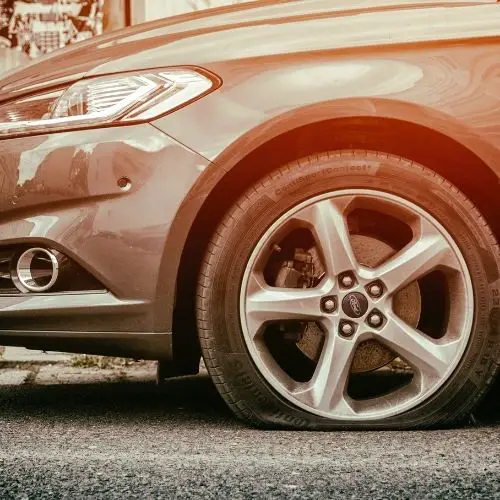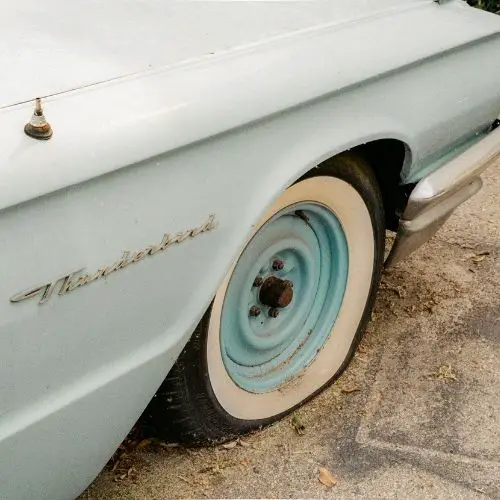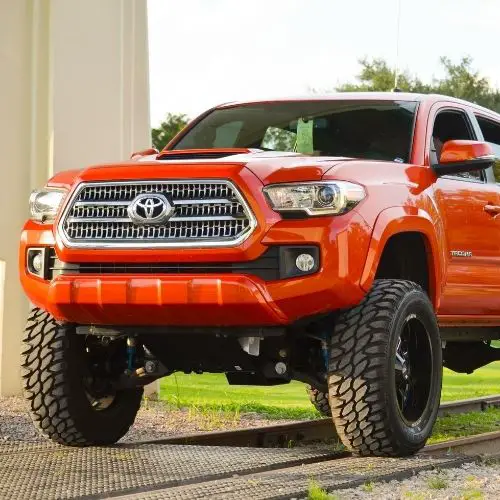We may get commissions for purchases made through links in this post. Thanks for the support! 👍
Filling your tires with the proper air pressure is important for proper control on the road, as well as maintaining fuel economy. When filling your tire, you should unscrew the tire pressure cap, then check the pressure in the tire. Next, fill the tire with air from the air hose, stopping to check the tire pressure. Repeat until you are at the desired pressure.
What You Need to Fill Your Tires With Air?

There are going to be a few things you will need to fill your tires with air.
Find your air pressure needs
Firstly, you will need to know what kind of pressure you should have your tires set at. This information can be located in the driver side door or door jam, or the owner’s manual. It is measured in something called PSI or Pounds-per-square-inch.
This is used as a way to measure how much force the air is supposed to exert on the walls of the tires. Note that many times, depending on the car, the PSI for the front and rear tires will be different depending on the placement of the wheel. You should make note of this when you go to fill up your tires.
Get a pressure gauge
Next, you will need a tire pressure gauge. This is a tool that is designed to measure the air in your tire. Good tire pressure gauges tend to be made of metal and can cost anywhere from $5 to $10 and are available both online and at most major retailers. It has a small cap on the top and a moveable measuring stick that comes out of the bottom.
When you place the cap portion of the tire pressure gauge on the tire valve, the air will blow into the handle of the gauge where the stick sits. This allows it to blow out the bottom of the gauge, giving you a reading to use.
We really like this pressure gauge right here! You get multiple for different vehicles, and it is on a budget.
Find yourself an air compressor
Then, an optional tool can be an air compressor. These are designed to compress the air through the air hose so you can force it into the tire. These can be something you may want to buy, as air from a compressor at gas stations may insist that you pay for the air.
An air compressor can typically cost anywhere from $100 to $200 depending on the brand and the features that come with it. Another optional piece of equipment is wearing hearing protection, as the air compressor can be loud for some users. If you are wanting to stay on a budget though, this one right here will get the job done well, and it is portable!
How to Fill Your Tires With Air

Before you begin you will want to do this with the tires as cold as possible. Heat, either from the air or the tires themselves as they move on the street can cause the air pressure to be distorted from what it actually is. Therefore, you should try and do this in the morning, when it is usually at the coldest time of day. This will help to give you as accurate a reading as possible.
- Place your car near the air compressor, then turn off the car.
- Start the air compressor or drop in the desired amount of money for the air at the gas stations. Wait for it to be fully compressed, and ready to use.
- Next, find the cap for the tire valve on the rim of the tire. Remove it and set it aside where you can easily find it again.
- Place the tire pressure gauge onto the tire valve. Allow the bottom of the tire pressure gauge to register. (Note: If you hear air leaking, then you have not gotten a proper seal between the head of the tire pressure gauge and the tire valve, and you need to repeat the process.)
- If the psi is what is recommended, then you are finished, and you can put the cap back on the tire valve. If not, then you need to repeat the process on the tire until you get the desired pressure.
- Repeat with the other three tires, and the spare if necessary.
- If you have an air compressor, then you need to be sure to release the compressed air for safety and the life of the product. Be sure to read the instructional manual as to how to do this properly.
What happens if your tires continue to deflate?
You will want to check that there are no punctures in your tires. A simple way you can do this is by using a tire plug kit. This is also an optional tool, and it can cost anywhere from $10 to $20 for the kit itself.
If you do end up finding the leak, and it is in the sidewall, then you might want to start thinking about replacing your tires. Unfortunately sidewall damage can’t be fixed in the same way a puncture in the tread can be, and replacement is the only reliable answer. If this happens to you, and you have a pickup, this article would likely be a great read!
- Should you be driving on unbalanced tires?
- 2 Tires vs 4 Tires: Should you replace all 4 tires every time?
- Jump Starting Your Car with a different Car: Is it Harmful to My Vehicle?
Frequently Asked Questions
Can you fill tires at home?
Filling up low tires at home is actually very easy! All you need is an air compressor, a tire gauge, and a bit of time. While filling up at a gas station or the like is definitely easier and faster, a home portable compressor can get that job done, but it might take a bit longer.
Can you put air in a completely flat car tire?
Theoretically you can fill a completely flat tire at home, however you need to keep an eye out on if the tire has lost its bead. Basically this means that the inside of the tire is no longer pressing up against your wheel, meaning that air will leak out no matter how much you add. Filling up a tire like this will likely need to be done at a shop for most people.
Can I fill a car tire with a bike pump?
Bike pumps should be able to handle filling a car tire with no issue! Why do most people not utilize this? Because it will take forever, and you will be exhausted by the end. Car tires require so much more air than mike tires that is just isn’t something most people want to do, however in an emergency, go for it!
Conclusion
That is all you need to do to check your tires for proper inflation. All you need is a tire pressure gauge, a way to get compressed air, and knowledge of what your ideal tire pressure should be like.
It may seem like a lot of steps, but once you get the hang of the process, it won’t take you long to check your tire pressure.


